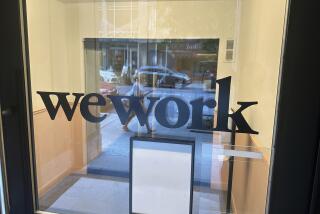Andersen Says Goodbye to Accounting
- Share via
Like the party guest who leaves long after the festivities have ended, Arthur Andersen officially exits the public accounting business today, leaving a shell of a company that was once an industry icon.
With its client base and its sterling reputation now just visions in the rear-view mirror, the first major accounting firm to be convicted of a felony hangs on in skeletal form, its global network that once boasted 85,000 employees reduced largely to mop-up crews in a few offices.
“As a practical matter, Andersen no longer exists as an auditing firm,” said Rusty Hardin, the private attorney who defended Andersen on obstruction-of-justice charges in the spring. The firm was convicted June 15 in connection with its shredding of documents for Enron Corp.
“By the time of sentencing [in October] they’ll be down to 16 partners, out of 1,700 [U.S. partners]. It will be a firm of, at most, several hundred people,” Hardin said.
And, added one source, “they’ve got litigation coming out of their ears.”
After its conviction, the firm founded in 1913 by Northwestern University accounting professor Arthur Andersen agreed to cease providing auditing services for publicly traded companies as of today.
And conceding that the jury verdict effectively ended its audit practice, the firm also opted to surrender, by today, its licenses in all 50 states to perform CPA services for companies public or private.
Even with its overseas network largely dissolved and its U.S. ranks thinned to less than 3,000 (from a high of 26,000) Andersen will remain “an ongoing business entity,” said Patrick Dorton, a company spokesman. But he and others within the company declined to specify exactly what it will be doing.
Hardin said the firm will still reap revenue from renting out a former Catholic college campus Andersen owns on the banks of the Fox River in St. Charles, Ill., about an hour west of the firm’s U.S. headquarters in Chicago.
Described by one visitor as an “absolutely gorgeous campus,” the facility had been used to hold training sessions for Andersen employees. Now it will be leased out to corporate customers, Hardin said.
“That revenue will look like nothing, $20 [million] to $30 million if they’re successful,” he said. That pales in comparison with the $4.3 billion pulled in by Andersen’s North American operation last year.
Most of those missing millions will now flow to former Andersen competitors--Ernst & Young, PricewaterhouseCoopers, Deloitte & Touche and KPMG, known as the Final Four--that have been busy snapping up Andersen assets since the company was indicted in March.
This week Andersen Worldwide, the umbrella organization for the international offices, announced plans to pay nearly $60 million to creditors, employees and shareholders of Enron, hoping to shield the other global offices from litigation. Arthur Andersen, the U.S. partnership, was not part of the two settlements, Dorton said.
Since the spring, the U.S. and worldwide branches have taken great pains to assert their independence from each other.
The U.S. arm is being run by an administrative council made up of at least four partners in Chicago, Atlanta, New York and Los Angeles, sources said. Offices in those cities, and in Houston, home of Enron, were still functioning this week at some level, albeit with a greatly reduced staff and with an unclear life expectancy. Nearly all other U.S. offices have been closed.
“It’s small, fewer than 100 people, and there were more than a thousand here 90 days ago,” said a company official describing the downtown Los Angeles office.
“The Chicago office is basically a skeleton crew,” said Allan D. Koltin, an accounting consultant who is a frequent visitor to Andersen’s U.S. headquarters. “You’ve got a handful of people and everyone’s been consolidated onto one floor.”
Despite widespread speculation the company will file for bankruptcy protection, company officials have said they do not intend to do so. Two weeks ago, Andersen filed a three-page motion in the U.S. District Court in Houston, saying that “it has not adopted any plan of dissolution and does not intend to dissolve on Aug. 31 or thereafter.”
Speculation that the firm was headed for bankruptcy was fueled in part by Andersen’s decision in March to hire Bryan Marsal as its chief restructuring officer. Marsal, who has worked extensively with bankrupt companies, has declined to comment.
Arthur Bowman, editor of the Atlanta-based Bowman’s Accounting Report, said he thinks “the firm is ultimately heading toward bankruptcy” but said the company may be putting off that course as long as possible.
Under U.S. bankruptcy law, deals struck by an insolvent company to sell assets up to a year before the filing could be voided if a bankruptcy judge determined that the deals were designed to channel money away from creditors.
That the firm may delay filing to ensure the safety of some of its deals “is certainly a possibility,” said Christopher Patti, counsel for the University of California, the lead plaintiff in a class-action lawsuit filed against Andersen and others by Enron shareholders.
“Andersen seems to be hanging on, though obviously it’s in severe financial difficulty,” Patti said.
Bill Brandt, president and chief executive of Development Specialists Inc., a Chicago-based restructuring firm, predicted in May that the firm would file for bankruptcy protection within a month. He said Friday that the “day of reckoning” for Andersen had been postponed because courts have refused to “sequester or embargo any of Arthur Andersen’s assets” as a hedge against any future judgments.
As the company awaits sentencing Oct. 11, the key issues are paying down debts, trying to get out of leases for now-shuttered offices and selling remaining assets, including practices, analysts said.
Acquiring firms have been paying Andersen, on average, more than $100,000 per partner--who typically bring with them a roster of clients, sources familiar with the deals said. In one of the largest transactions, Deloitte & Touche in the spring acquired 2,000 people, including almost 200 partners in the tax practice.
Bowman said the industry transition from five major players to four “actually has not been chaotic.” Rival firms seeking to acquire an Andersen audit or tax team have typically negotiated the deal through the Chicago office.
There is a big incentive for companies to keep the audit team because switching to a new firm can double the costs for the first year, said Mark Cheffers, chief executive of AccountingMalpractice.com.
There are other options for the firm, including consulting and non-CPA tax work. But although the company has vowed to appeal the verdict after sentencing, even Hardin agreed a reversal would not make the company whole again.
“It’s an appeal to set the record straight,” Hardin said, “and give the employees a chance to not be considered felons.”
More to Read
Inside the business of entertainment
The Wide Shot brings you news, analysis and insights on everything from streaming wars to production — and what it all means for the future.
You may occasionally receive promotional content from the Los Angeles Times.










